Let us imagine some ideal consumer mobile technologies. He can not live without e-mail, the Internet is ready to go as soon as possible, and so on. And, unfortunately, all his life - one big road. That in this way with him to take to not feel cut off from the world? Note that our restless man - a Russian, and he has to move on domestic and blizhnezarubezhnym towns and villages. The nearby - on the car to the remote - on trains and planes. Sometimes it fills in the far abroad. To begin with we choose our bedolage the appropriate phone. Clearly, it should be as mobile as its owner. That is, cellular or satellite. Satellite phone works everywhere, except perhaps that the region of eternal ice at the poles of the planet. However, the cost of equipment and, most importantly, pay for air time are unlikely to enjoy our economical entity. He thinks spending a mirror and looking toward popular now mobile. Now Russia has almost all the "big" international standards of cellular communication: GSM, NMT, CDMA, AMPS and all sorts of modifications. NMT is officially considered a federal cellular standard, GSM has the same de facto status. The remaining two are valid only in certain regions and cities, with virtually no developing. We discard them immediately - our users can not limit the geography of displacement of the boundary of a given region, in addition, he is inclined to choose the best. NMT network for data transmission fits poorly: analog, very noisy, constant risk of sudden disconnection. In addition to work with phones by NMT takes quite drogostoyaschee equipment: special modems, fax adapters, etc., and not all Internet service providers are able to handle the cellular connection. GSM in this area is far more attractive. Large operators now connect the data service for free, provide great discounts on airtime, special gateways to quickly access the Internet, etc. GSM networks cover almost completely the Moscow and Leningrad regions, most cities and major highways. Between the majority of these networks can auto-roaming, and overseas GSM phone owner does not feel like a stranger. In general, our hypothetical user selects a standard GSM. There are so many phones running in the standard GSM, sold by virtually nothing unpretentious tubes to "clever" devices for a few hundred dollars. Choose to have their own preferences, but will not be superfluous to ask if they support this model of phone data, whether it is possible to get cable and software for connecting the handset to the computer and how much it will cost. Very useful if your phone has an infrared port and built-in modem, in this case, you can do at all without wires. These phones include Siemens S25 and S35, Nokia 6210, 7110 and some others. Infrared port without a modem malopolezen. Our hero is inexperienced in these matters, therefore, for a start, he thoroughly studied the issue. And found that not only improper phone model can be an obstacle. Some tariff plans of mobile operators do not provide data services at all. We should not rush headlong to the apparent cheapness of the issue requires thoughtful reflection and the Board of knowledgeable people. Our practical, user selects the phone with an infrared port and a modem: Siemens S25. Let not the most fashionable model, but reliable and well suited to data transmission. When buying it is satisfied that the tariff plan includes short message service SMS, data service and found a short telephone Internet gateway operator.
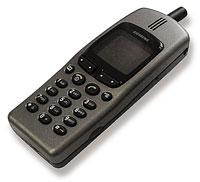 |
The phone is. Let's see how you can connect it to your computer. The most common way to connect - with a special GSM-compatible PC Card (or Compact Flash) modem. This modem can be used as conventional dial-up lines, and for the cell phone, you need only a special cord.PC Card modems can work with any modern laptop computers as well as Windows CE platform and Psion, which have internal or external slot, PCMCIA, and Compact Flash Modem - with computers equipped with a slot Compact Flash. Today, GSM-compatible modems in PC Card formats and Compact Flash cards produce a variety of companies and find them - no problem. Lack of GSM-compatible modem - a rather high cost, as well as very high energy consumption. Note also that the computer may have the right slot, but does not support the modem (for example, a PDA Psion Series 5mx). Cheaper and more convenient to buy a kit to connect the cell phone directly to a serial (COM) port on your computer. It consists of a special cable and CD-ROM with software, ustanavlivaemomgo on your PC. Typically, a set of software includes programs to adjust the cell phone and reception-send SMS. These kits produce vendors themselves (complete Nokia Data Suite, for example), and third parties. Very popular is the Option Softradius, produced in versions for all modern GSM-handsets. The third option - it is generally refuse to harness and communicate with the phone via an infrared beam. To this end GSM-handset must have built-in modem and an infrared port. Computer, of course, must also be equipped with a compatible infrared port and support for your model phone. This method is the most simple and suitable for any modern computer, from laptop to Palm'a. A small inconvenience - during communication infrared ports of both devices should be kept on one line between them should not be obstacles. Upon reflection, our until the user decided to use an infrared connection, the benefit of buying the phone, he took care of that possibility. This method does not require any additional costs. Various exotic modes of communication such as cellular phones on the cards PCMCIA, GSM-SnapOn adapter for Palm, infrared modem, which connects phone cord, etc. not consider. They are expensive, few common and not very necessary for our users. With the connection seems clear. Business for small - to choose the right computer. Began our inquisitive user with a very large, serious and friendly - with laptops.
Selection of a suitable computer
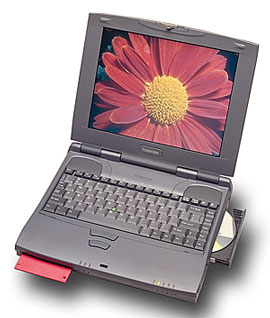 |
Only the laptop can replace a desktop PC, remains a distant office. Full compatibility with Windows, the same e-mail program, Web-browser, office applications, as a member on any PC, the ability to install any additional software, if necessary. The notebook is good in all respects except one. It can be moved from place to place, but work at the moment no job is difficult. Laptop to put on the table, his hands comfortably on the keyboard, put it. To connect the network again, so do not waste batteries. Very quickly it became clear that the laptop is not well suited for operation in a marching office. On the knee does not work, shake and drop a pity such an expensive thing. But if you reach the table, even with the socket, then the awkward suitcase laptop into a powerful computer capable to solve any problem. By the GSM cell phone laptop connects to any of the above methods. The only pity is that most of your laptop when cellular connections will be unrealizable in a narrow channel of communication at 9600 bps. Nearest neighbors notebooks - the so-called "subnotebooks". From older relatives, they are compact and light weight. Typical of the family subnoutov - Toshiba Libretto and Cassiopeia Fiva. Not much more videotapes of possibilities they are not much inferior to this notebook: the same operating system Windows 95/98, the same set of applications, the same broad compatibility, wide choice of low-cost peripherals. The reverse side close to pocket size - less comfortable keyboard, a small screen area, not too outstanding hardware performance.
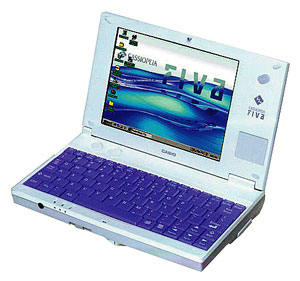 |
Go ahead. For subnotebooks are computers Platform HPC Pro. This family includes a variety of computer classes and forms: subnotebooks, palmtops, tablets. Despite the apparent dissimilarity, they have a central unifying feature: the operating system Windows CE. Windows CE computers, and in fact very similar to the "big" PC. Even the names of the applications differ only in the "pocket" prefix Pocket: Pocket Outlook (organizer and e-mail), Pocket Internet Explorer (Web-browser), Pocket Word, Pocket Excel, Pocket Access, etc. CE-functionality applications more modest than the real Word, Excel, etc. However, they have superior quality - compatibility. File created on a desktop PC can be easily opened, edited, forwarded or printed on the printer. Compatibility eliminates the problem of reading e-mail attachments - just open it with one of the built-in applications. Unfortunately, this may be lost complex formatting, macros, embedded objects. But: the program running under Windows 98 will not run in the environment of CE. Therefore, set upon him, "1S", "Guarantor" or a corporate database will not work. Go to the mobile phone HPC Pro connected to any of the mentioned methods. The maximum that may need to do - is to install the driver.
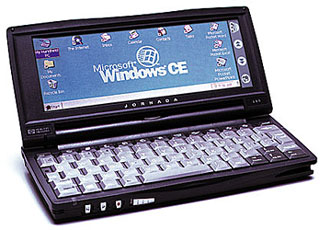 |
Very pleased with our mobile user to trouble-free reading mail and Web pages in Russian - built four Cyrillic encodings! A disappointed offensively short battery life. 5-7 hours when power is on - and start searching for the outlet. Because of this, always having to carry a charger.
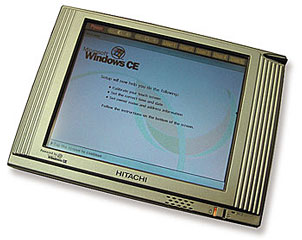 |
Another interesting class of devices - Pocket PC. The title translates as "Pocket PC" and is fully consistent with the idea that computer. In the box that fit in the palm of your hand, there is virtually every business and Internet applications. And also: MP3-player, slide shows, graphics and applets, etc. etc. Working with e-mail, the Internet, as well as processing of office documents, tables and graphics should be simple, for design reasons, be "one touch" As well as HPC Pro, Pocket PC platform is made as compatible with Windows. Perhaps, Pocket PC are the smallest computers capable of opening and processing files of Microsoft Office 2000. Unfortunately, when zapihivanii functional HPC Pro in his pocket, he had a lot of cut. They cut to the quick. Not one Russian encoding in your email program and browser are not preserved. From Word and Excel were pitiful scraps, even compared to the HPC Pro. In addition, a vertical screen resolution of 240x320 is not very suitable for formatting documents, working with tables. Internet on such a screen is also not impressive. Print Pocket PC can not. Pocket PC does not show anything outstanding in terms of efficiency: only 6-8 hours of charging before charging.
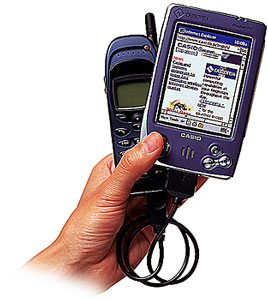 |
Connecting to a cellular telephone - in any way. The only requirement: a modem should be the one available in a specific Pocket PC expansion slot. And to connect the phone to the serial port will need to buy a special cord or carry a cradle-stand. Our curiosity of users turned it into the hands of the beautiful cars and set aside. For the basis of this mobile office keyboardless Pocket PC fit enough - you need something more serious.Proceed to the Psion. More precisely, this platform is now called the EPOC 32. This PDA keyboard, designed for autonomous operation. They differ in efficiency, low system hardware resources. And to do so at the expense of functionality. Office applications EPOC let you work on your Pocket PC as on a small laptop. Diary and address book is reliable and easy to use. E-mail program is very good and convenient. Their email in it combined with fax and SMS. There is a Web-browser or, more precisely, for two, WAP-browser etc. Unfortunately, not so good things with communications in Russian. Despite all the efforts of Russian developers, train EPOC32 Cyrillic in full so far failed. There are problems with reading e-mail attachments.
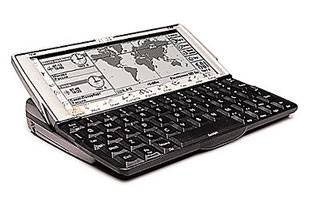 |
Psion good as the core of the "easy" mobile office, the owner of which has to correspond via email with a certain circle of correspondents who send each other e-mail based karmannokompyuternoy specificity (no attachments). Also very convenient organized processing of short messages SMS. The optimal way to connect to a mobile phone - the infrared beam. In this case, do not have to buy accessories, quite the case with the Psion expensive. Finally, the smallest Pocket PC - Palm. Today in Palm platform include: sobctvenno Palm, Handspring Visor, TRG Pro, Sony Clie, and others. Immediately make a reservation: Palm does not claim the status of core mobile office. According to the ideology of Palm - is a convenient addition to your PC, quickly and easily share them with data. It is believed that e-mail at the beginning of turns on the PC (laptop), and then if necessary, can be loaded into the Palm, it read and processed. The same approach - with an electronic newspaper AvantGo, which is loaded in a Palm from the Internet through the mediation of a PC. There are, of course, and stand-alone e-mail clients, and various Web-browsers and word processors and spreadsheets, and a lot more then for the Palm. But even the best of them will not allow 100% use a Palm as a major link mobile office. It is made for the other - to be always at his master, to store operational information and deliver it whenever the need to include a laptop, if you need to watch or record the phone or make a short note for memory. If necessary, Palm is able to for some time to replace the current computer. Put the palm Palm, mobile phone compatible their infrared ports, and can work with.
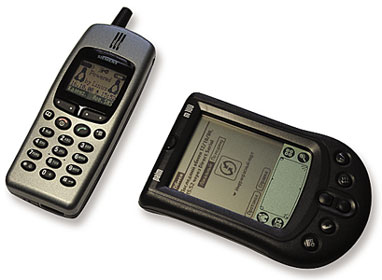 |
What follows from the above? Only that the ideal "mobile office" does not exist yet. And each set of tasks will be to a greater or lesser extent, solved by a certain set of tools. Here are some considerations for choosing a computer to a mobile office: 1. Maximum functionality. Work in the Internet, graphics, databases, with accounting, legal and other packages. Programming, Web-design. ... Notebook or subnotebook















